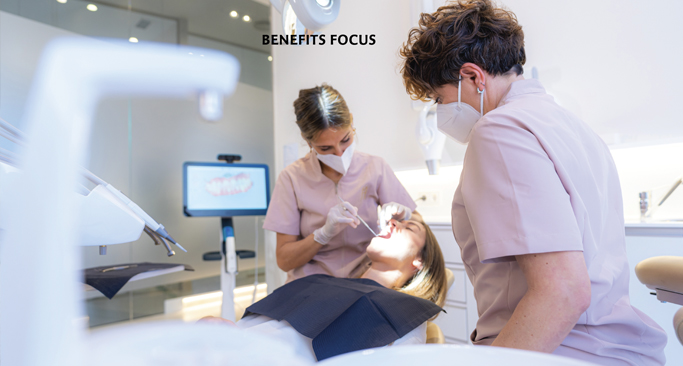Reports show that dental care use is on
the rise, along with the cost of that care
By Len Strazewski
Dentists used to have neighborhood offices—sometimes above a local drug store—and patients would climb the stairs when a tooth began to hurt. After some drilling and filling, the patient would pay cash and promise to come back in six months for an examination.
Dental services are now more often than not corporate functions operated by group practices with online scheduling and email billing and services that include orthodonture, implants and cosmetics.
And patients are more likely to cover their costs with dental insurance from an employer. As dental services and benefit utilization continues to grow, the trend is creating an increasing demand for dental benefits, according to the American Dental Association (ADA). The National Trends in Dental Care Use report by the ADA and the Health Policy Institute, which was updated in 2024, indicates that dental care use is on the rise—along with the cost of that care.
In 2022, a record 293 million Americans had dental coverage according to the 2023 Dental Benefits Report: Enrollment, recently published by the National Association of Dental Plans (NADP).
About 61% of all commercial group dental benefits are employer-sponsored, and the other 39% are voluntary benefits. About 5.8% of the population with commercial dental benefits has coverage through individual policies and products. Less than two percent of commercial dental benefits are integrated with medical policies. Nearly half of group dental benefits, 45%, are self-insured.
The latest NADP research shows that 88% of the population has dental coverage, including Americans receiving benefits through employer-sponsored or other group plans, individual plans, or public benefits. Enrollment in publicly funded benefits increased significantly, up 22.4% in 2022 compared to 2021. However, enrollment in commercial dental benefits was flat compared to 2021.
About 45% of the U.S. population visited a dentist in 2022, the research reveals, and about 61% have private dental insurance, slightly more than previous years, even though the benefits have been relatively stable, the research says. About 52% of children visited a dentist.
About 13% of the population reported cost barriers to dental care, compared to 4% to 5% for other healthcare services. Most people find value in having dental insurance; only about 20% of those surveyed reported that they did not have dental insurance to cover treatment costs. In general, usage has rebounded to pre-COVID levels, the study says.
After additional life insurance, dental insurance is the second most subscribed supplemental benefit, selected by 51% of employees, according to the 2024-2025 Aflac Workforces Report. About 61% of employees surveyed said they were interested in purchasing dental insurance, only one percent behind general hospitalization.
The latest NADP research shows that 88% of the population has dental coverage, including Americans receiving benefits through employer-sponsored or other group plans, individual plans, or public benefits.

Costs are driving workers’ interest, making dental supplemental benefits more attractive than ever, according to Kara Hoogensen, senior vice president of workplace benefits at Principal Financial Group.
Most examinations were completely covered by past dental plans, a testimony to preventative plan design. Fillings or extractions used to cost in the hundreds of dollars at most and plans often paid 50% to 80% of the costs. Dental caps were pricey, but workers shared the costs with the employer plans.
Implants and cosmetic dentistry, which corrects dental problems that may have started in childhood, have driven dental costs way up, and employees have come to rely on their employers to provide larger portions of the costs, Hoogensen explains.
Employers can provide various tiers of benefits and structures, she says, and the benefits vary by industry and geography. “The key is to understand what similar employers offer, and we have a lot of tools that help brokers and their clients understand what their employees most value.”
Principal also helps brokers and clients package their supplemental benefits, and most employers include dental with short- or long-term disability and term life insurance. The insurer provides a large national preferred network of up to 135,000 providers and allows employers to pay various portions of premium costs.
The insurance can cover as few as two employees and can include periodontal disease, cancer treatment, general anesthesia, and second opinion options.
Brad Peak, assistant vice president and head of dental and vision benefits products and strategy at Sun Life U.S., says that dental insurance is evolving in several ways to help workers manage the dental service costs with higher maximums and more flexibility in what the plans will pay.
Sun Life has a nationwide preferred provider organization (PPO) network of 140,000 dentists and has been building comprehensive preventive services including a Preventive Rewards program and the ability to roll over a portion of the benefits maximum.
“Dental benefits have been very cost effective,” Peak says. “Premiums have only been going up slightly, one-half percent to two and a half percent a year. Maximums have been creeping up, and deductibles have been moving down. Employers have been seeking broader coverage for their workers, including orthodonture and cosmetic surgery.
“More and more employers want broader coverage to meet their employees’ and their families’ needs,” he says. “It’s not just about remedial treatment.”
The new focus is on preventive care, he says, and many plans pay for examinations two or three times a year rather than annually to allow plan participants to use plan resources strategically rather than to respond only to emergencies.
Sun Life’s Preventive Rewards allows plan participants who use the examinations successfully to add to their maximums for the coming year, so more expensive procedures can be budgeted for in the future and paid out of plan assets. The new features are “very popular,” Peak says.
Also popular is the idea of taking a comprehensive approach to general health and wellness. According to Peak, “Employers have become very interested in integrating dental care benefits with general medical benefits to address general health issues. Wellness benefits include all levels of health benefits, including dental care.”
Though Aflac is known mainly for its supplemental accidental and disability insurance programs, the company also maintains a large dental benefits program with a provider network of about 100,000 providers, integrated with the company’s other programs.
“Aflac Dental and Vision insurance is an essential component of any holistic financial protection plan, and it serves as a gateway for our customers to gain exposure to Aflac’s premier suite of benefits solutions,” said Aflac Incorporated and Aflac U.S. President Virgil Miller, in a recent press release.
Jon Edgington, senior vice president of dental and vision at Aflac, says that the insurer has recently increased maximums to $1,500 to be competitive with other insurers and lowered deductibles for a broader level of coverage.
“Dental insurance is most often sold bundled with other supplemental coverage, such as vision and critical illness insurance, as employers have come to realize the varying need of their employees,” he says. Dental insurance is now one of the top three supplemental benefits sold by Aflac.
While dental insurance is an optional supplemental coverage for most employers, it is generally available at large employers and has grown to become considered a core benefit paid in part by the employers, he says. About 50% to 100% of workers at large employers choose dental insurance as a supplemental benefit.
A growing number of small employers now offer dental insurance as a competitive addition to their benefits, he says, packaged with accident or term life insurance.
For more information:
Aflac
aflac.com
Principal Financial Group
principal.com
Sun Life U.S.
sunlife.com/us
The author
Len Strazewski is a Chicago-based writer, editor and educator specializing in marketing, management and technology topics. In addition to contributing to Rough Notes, he has written on insurance for Business Insurance, Risk & Insurance, the Chicago Tribune and Human Resource Executive, among other publications.






